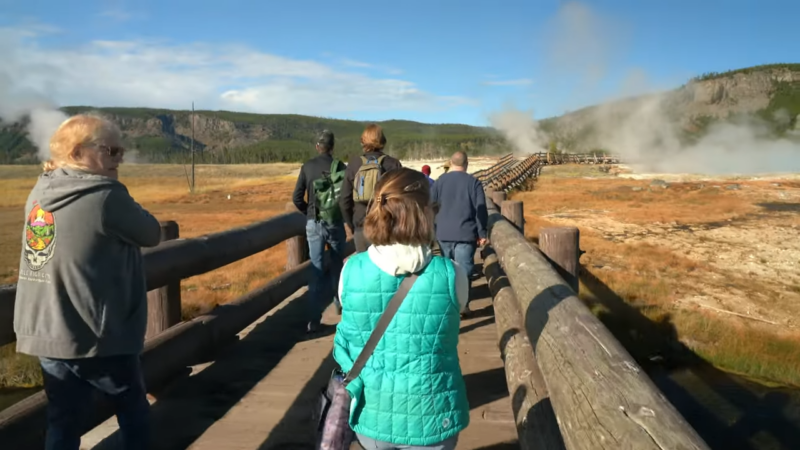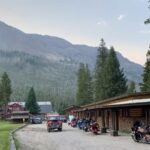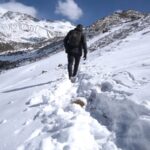When it comes to exploring the great outdoors, few places rival the majestic beauty and diverse ecosystems of Yellowstone National Park.
With its geysers, hot springs, lush forests, and abundant wildlife, it’s a hiker’s paradise waiting to be discovered.
One of the first decisions you’ll face is whether to embark on a guided hiking tour or venture out on your own.
While both options offer unique experiences, opting for a guided tour is often the better choice, especially for first-time visitors.
Key Takeaways
- Late spring to early fall offers ideal conditions; early September is great for fewer crowds and mild weather.
- Choose trails based on difficulty—Fairy Falls (easy), Mount Washburn (moderate), and Sky Rim (challenging).
- Backcountry permits are required for overnight stays; fishing requires a Yellowstone-specific permit.
- Carry bear spray, store food properly, and keep at least 100 yards from bears and wolves.
- Wear layers, bring a first-aid kit, water, navigation tools, and snacks.
- Ideal for first-time visitors—guides offer knowledge, safety, and access to hidden trails.
1. Choosing the Right Time to Visit
Yellowstone experiences a range of weather conditions throughout the year, and your choice of season can significantly impact your hiking experience.
Spring (April to June):
- Pros: Fewer crowds, blooming wildflowers, and the birth of wildlife offspring.
- Cons: Unpredictable weather with potential snow, rain, and trail closures.
Summer (July to August):
- Pros: Warm weather, fully accessible trails, and a plethora of ranger-led programs.
- Cons: Peak tourist season leading to crowded trails and accommodations.
Autumn (September to October):
- Pros: Stunning fall foliage, cooler temperatures, and fewer visitors.
- Cons: Shorter daylight hours and the possibility of early snowfall.
Winter (November to March):
- Pros: Serene landscapes blanketed in snow, unique wildlife sightings.
- Cons: Many facilities are closed, limited trail access, and extreme cold.
Yellowstone boasts over 900 miles of hiking trails ranging from easy boardwalks to challenging backcountry routes.2. Select the Trail
Easy Trails
2.1. Fairy Falls Trail
- Distance: Approximately 5 miles round trip
- Elevation Gain: Minimal, around 70 feet
- Trailhead Location: Near the Midway Geyser Basin, off the Grand Loop Road
Highlights:
- Leads to Fairy Falls, a stunning 200-foot waterfall
- Views of the Grand Prismatic Spring from an overlook
- Opportunities to see wildlife like birds and small mammals
Tips:
- Best Time to Visit: Late spring to early fall when the trail is free of snow
- Amenities: No restrooms along the trail; restrooms available at the trailhead
- Wildlife Caution: Be bear-aware; carry bear spray and make noise to avoid surprise encounters
2.2. Mystic Falls Trail
- Distance: Approximately 2.5-mile loop
- Elevation Gain: About 500 feet
- Trailhead Location: Biscuit Basin, 2 miles north of Old Faithful
Highlights:
- Views of geysers and hot springs in Biscuit Basin
- Mystic Falls, a picturesque 70-foot waterfall
- Panoramic vistas of the Upper Geyser Basin from observation points
For those seeking a bit more adventure, an optional loop trail climbs to an overlook providing expansive views of the Upper Geyser Basin and the surrounding mountains. The ascent is moderate but rewards hikers with stunning panoramas.
Tips:
- Best Time to Visit: Summer and early fall
- Trail Conditions: Some steep sections on the loop trail; wear appropriate footwear
- Safety: Stay on designated trails to protect fragile geothermal areas
Moderate Trails
2.3. Mount Washburn Trail
- Distance: About 6 miles round trip via Dunraven Pass (longer if starting from Chittenden Road)
- Elevation Gain: Approximately 1,400 feet
- Trailhead Location: Dunraven Pass or Chittenden Road
Highlights:
- Panoramic 360-degree views from the summit
- Wildflowers in summer months
- Potential sightings of bighorn sheep and other wildlife
Mount Washburn stands as one of Yellowstone’s most accessible peaks, offering hikers sweeping views of the park’s vast wilderness. The trail from Dunraven Pass is well-graded and follows an old roadbed, making the ascent manageable for those with moderate fitness levels.
Tips:
- Best Time to Visit: Late June through September; snow can linger into early summer
- Weather Considerations: Be prepared for sudden weather changes; the summit can be windy and cold
- Wildlife: Keep an eye out for bears and bighorn sheep; maintain a safe distance
2.4. Elephant Back Mountain Trail
- Distance: Approximately 3.5-mile loop
- Elevation Gain: Around 800 feet
- Trailhead Location: Across from Fishing Bridge Visitor Center near Yellowstone Lake
Highlights:
- Dense forests of lodgepole pine and spruce
- Scenic overlook of Yellowstone Lake and the Absaroka Mountain Range
- Quieter trail with fewer hikers
The Elephant Back Mountain Trail offers a moderately challenging hike through serene woodlands leading to a rewarding viewpoint. The trail starts with a gentle incline through thick forests, providing a peaceful atmosphere and chances to spot wildlife like elk and foxes.
Tips:
- Best Time to Visit: Spring to fall; trail may be muddy in early season
- Trail Navigation: Trail junctions are marked, but carrying a map is advisable
- Bear Safety: This area is known for bear activity; carry bear spray and hike in groups if possible
Challenging Trails
2.5. Specimen Ridge Trail
- Distance: Approximately 18 miles one-way (can be done in sections)
- Elevation Gain: Over 3,000 feet
- Trailhead Location: Near Tower Junction or Lamar Valley
Highlights:
- Petrified forests with fossilized trees
- Sweeping views of the Lamar Valley, known as America’s Serengeti
- Abundant wildlife, including bison, elk, and wolves
The Specimen Ridge Trail is a strenuous trek recommended for experienced hikers seeking solitude and adventure. The trail traverses high ridges and open meadows, offering unparalleled views of the park’s northeastern region.
Due to its length, hikers often tackle sections of the trail or plan an overnight backpacking trip. The route requires good navigation skills, as some parts are less clearly defined.
Tips:
- Best Time to Visit: Summer and early fall; snow can make the trail inaccessible at other times
- Preparation: Bring topographic maps and possibly a GPS device
- Permits: Overnight trips require a backcountry permit obtained from the park service
2.6. Sky Rim Trail
- Distance: Approximately 20-mile loop
- Elevation Gain: Around 3,000 feet
- Trailhead Location: Near Bacon Rind Trailhead, off Highway 191
Highlights:
- High alpine ridges with 360-degree views
- Wildflowers and diverse ecosystems
- Less-traveled trail offering solitude
The Sky Rim Trail is considered one of Yellowstone’s most challenging and rewarding hikes. The trail climbs steeply through forests and meadows before reaching the ridgeline that forms the park’s northwestern boundary.
Due to its length and elevation gain, the trail demands excellent fitness and preparation. Weather can be unpredictable at high elevations, so hikers should be equipped for varying conditions.
Tips:
- Best Time to Visit: July to September; snow can linger on ridges into summer
- Water Sources: Limited; carry sufficient water or have the means to treat natural sources
- Safety: Thunderstorms are common in the afternoon; aim to be off exposed ridges by early afternoon
3. Obtaining Necessary Permits
Be aware that most backcountry campsites have group size limits, typically accommodating 4 to 12 people, to minimize environmental impact.
If you plan to fish during your visit, you’ll need a Yellowstone National Park fishing permit, as state licenses are not valid within the park.
These permits are available at visitor centers, ranger stations, and some general stores within the park.
The park has specific fishing regulations to protect native species, such as mandatory catch-and-release for certain fish and restrictions on gear like the prohibition of bait fishing.
Familiarizing yourself with these rules ensures the protection of the park’s aquatic ecosystems.
Besides backcountry and fishing permits, other considerations include park entrance fees and special use permits for activities beyond typical recreation, such as organized events or commercial filming.
4. Preparing Physically
Hiking in Yellowstone can be physically demanding due to high elevations and variable weather.
- Cardiovascular Training: Engage in activities like running, cycling, or swimming to build endurance.
- Strength Training: Focus on leg muscles with exercises like squats and lunges.
- Acclimatization: If possible, spend a day or two at higher elevations before your hike to adjust.
5. Packing the Right Gear
Clothing:
- Layers: Wear moisture-wicking base layers, insulating mid-layers, and waterproof outer layers.
- Footwear: Invest in sturdy, waterproof hiking boots with good ankle support.
- Accessories: Bring hats, gloves, and sunglasses for sun and wind protection.
Equipment:
- Backpack: A comfortable pack with a capacity suitable for your hike duration.
- Navigation Tools: Maps, compass, and GPS device.
- Hydration: Water bottles or a hydration bladder (aim for at least 2 liters per day).
Essentials:
- Food: High-energy snacks and meals like trail mix, energy bars, and dried fruits.
- First-Aid Kit: Include bandages, antiseptic wipes, pain relievers, and any personal medications.
- Multi-Tool or Knife: Useful for repairs and emergencies.
- Headlamp or Flashlight: For visibility during early mornings or late evenings.
6. Wildlife Safety
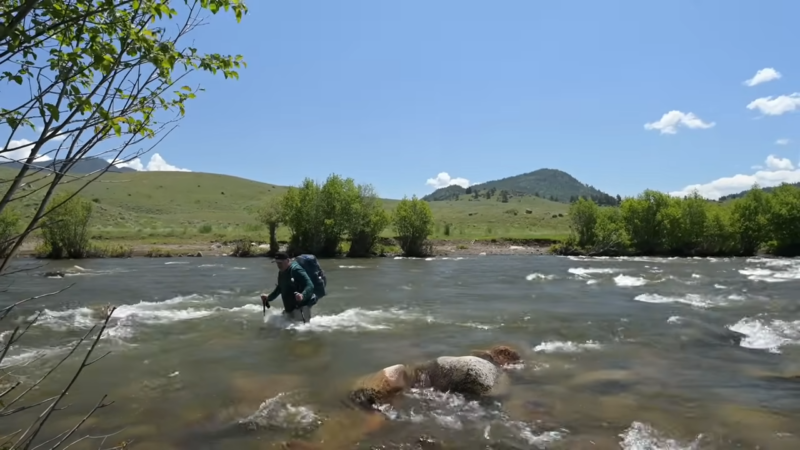
7. Planning for Emergencies
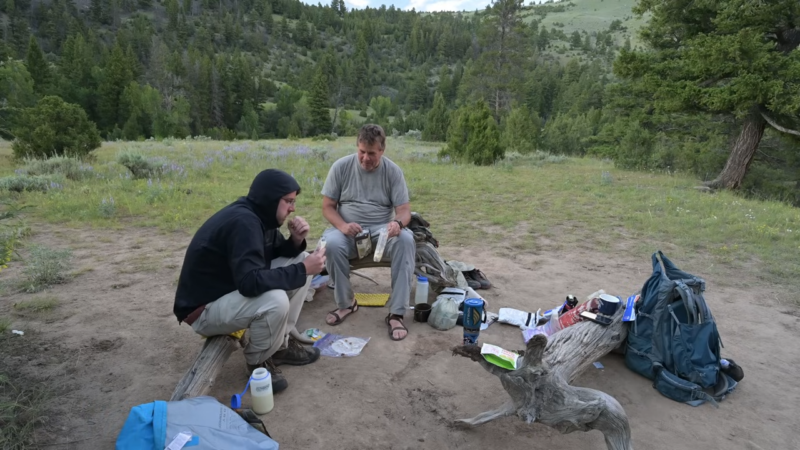
Preparation can make the difference in an emergency situation.
- Communication Devices: Carry a fully charged mobile phone (though service is limited), a satellite phone, or a personal locator beacon.
- Emergency Contacts: Inform someone of your itinerary and expected return time.
- Weather Awareness: Regularly check weather forecasts and be prepared for sudden changes.
8. Adhering to Leave No Trace Principles
Preserving the natural beauty of Yellowstone is crucial.
- Plan Ahead and Prepare: Know the regulations and special concerns for the area you’ll visit.
- Travel and Camp on Durable Surfaces: Stick to established trails and campsites.
- Dispose of Waste Properly: Pack out all trash, leftover food, and litter.
- Leave What You Find: Do not take rocks, plants, or historical artifacts.
- Minimize Campfire Impact: Use a camp stove for cooking and consider using a lantern for light.
- Respect Wildlife: Observe from a distance without disturbing.
- Be Considerate of Other Visitors: Keep noise levels down and yield to other hikers.
9. Opting for a Guided Tour
Guides offer valuable knowledge about the park’s geology, wildlife, and history, adding depth to your adventure.
They also provide an extra layer of safety, being trained in first aid and bear safety.
Guided tours often reveal hidden trails and sights that independent hikers might miss, while handling logistics like permits, gear, and meal planning, making the trip hassle-free.
When choosing a tour company, look for one with strong reviews and experienced guides.
Smaller groups generally offer more personalized experiences, allowing closer interactions with the guide.
Some tours also cater to specific interests, such as photography, wildlife observation, or geological exploration, so select one that matches your goals for the trip.

i am Will Chang an Montana hiker and i like to share adventures and tips here, where i can highlight the beauty and challenges of Montana’s rugged trails. My love for hiking led me deep into Montana’s breathtaking landscapes, from the towering Rockies to serene alpine lakes, always in search of the next unforgettable vista. Through thisblog, i want to inspire readers to explore the wilds, blending practical advice with passion for nature and the outdoors.

